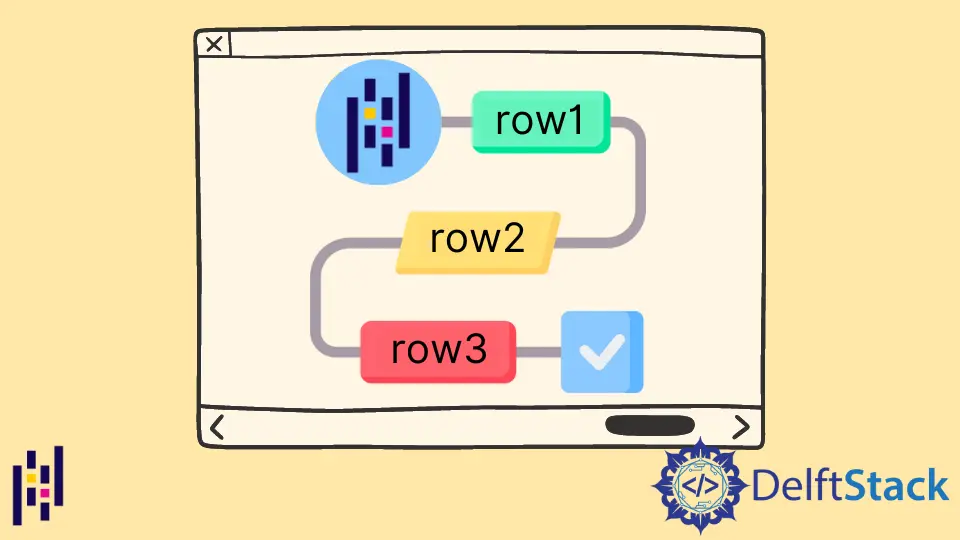如何在 Pandas 中遍历 DataFrame 的行
- 使用 index 属性来遍历 Pandas DataFrame 中的行
-
loc[]方法来遍历 Python 中的 DataFrame 行 -
在 Python 中用
iloc[]方法遍历 DataFrame 行 -
pandas.DataFrame.iterrows()遍历 Pandas 行 - pandas.DataFrame.itertuples 遍历 Pandas 行
-
##
pandas.DataFrame.apply遍历 Pandas 行

我们可以使用 DataFrame 的 index 属性遍历 Pandas DataFrame 的行。我们还可以使用 DataFrame 对象的 loc(),iloc(),iterrows(),itertuples(),iteritems() 和 apply() 方法遍历 Pandas DataFrame 的行。
在以下各节中,我们将使用以下 DataFrame 作为示例。
import pandas as pd
dates = ["April-10", "April-11", "April-12", "April-13", "April-14", "April-16"]
income1 = [10, 20, 10, 15, 10, 12]
income2 = [20, 30, 10, 5, 40, 13]
df = pd.DataFrame({"Date": dates, "Income_1": income1, "Income_2": income2})
print(df)
输出:
Date Income_1 Income_2
0 April-10 10 20
1 April-11 20 30
2 April-12 10 10
3 April-13 15 5
4 April-14 10 40
5 April-16 12 13
使用 index 属性来遍历 Pandas DataFrame 中的行
Pandas DataFrame 的 index 属性提供了从 DataFrame 的顶行到底行的范围对象。我们可以使用范围来迭代 Pandas 中的行。
import pandas as pd
dates = ["April-10", "April-11", "April-12", "April-13", "April-14", "April-16"]
income1 = [10, 20, 10, 15, 10, 12]
income2 = [20, 30, 10, 5, 40, 13]
df = pd.DataFrame({"Date": dates, "Income_1": income1, "Income_2": income2})
for i in df.index:
print(
"Total income in "
+ df["Date"][i]
+ " is:"
+ str(df["Income_1"][i] + df["Income_2"][i])
)
输出:
Total income in April-10 is:30
Total income in April-11 is:50
Total income in April-12 is:20
Total income in April-13 is:20
Total income in April-14 is:50
Total income in April-16 is:25
它将每行的 Income_1 和 Income_2 相加并打印总收入。
loc[] 方法来遍历 Python 中的 DataFrame 行
loc[] 方法用于一次访问一行。当我们在遍历 DataFrame 的循环中使用 loc[] 方法时,我们可以遍历 DataFrame 的行。
import pandas as pd
dates = ["April-10", "April-11", "April-12", "April-13", "April-14", "April-16"]
income1 = [10, 20, 10, 15, 10, 12]
income2 = [20, 30, 10, 5, 40, 13]
df = pd.DataFrame({"Date": dates, "Income_1": income1, "Income_2": income2})
for i in range(len(df)):
print(
"Total income in "
+ df.loc[i, "Date"]
+ " is:"
+ str(df.loc[i, "Income_1"] + df.loc[i, "Income_2"])
)
输出:
Total income in April-10 is:30
Total income in April-11 is:50
Total income in April-12 is:20
Total income in April-13 is:20
Total income in April-14 is:50
Total income in April-16 is:25
在这里,range(len(df)) 生成一个范围对象以遍历 DataFrame 中的整个行。
在 Python 中用 iloc[] 方法遍历 DataFrame 行
Pandas DataFrame 的 iloc 属性也非常类似于 loc 属性。loc 和 iloc 之间的唯一区别是,在 loc 中,我们必须指定要访问的行或列的名称,而在 iloc 中,我们要指定要访问的行或列的索引。
import pandas as pd
dates = ["April-10", "April-11", "April-12", "April-13", "April-14", "April-16"]
income1 = [10, 20, 10, 15, 10, 12]
income2 = [20, 30, 10, 5, 40, 13]
df = pd.DataFrame({"Date": dates, "Income_1": income1, "Income_2": income2})
for i in range(len(df)):
print(
"Total income in " + df.iloc[i, 0] + " is:" + str(df.iloc[i, 1] + df.iloc[i, 2])
)
输出:
Total income in April-10 is:30
Total income in April-11 is:50
Total income in April-12 is:20
Total income in April-13 is:20
Total income in April-14 is:50
Total income in April-16 is:25
这里的索引 0 代表 DataFrame 的第一列,即 Date,索引 1 代表 Income_1 列,索引 2 代表 Income_2 列。
pandas.DataFrame.iterrows() 遍历 Pandas 行
pandas.DataFrame.iterrows() 返回的索引该行以及该行的整个数据为系列。因此,我们可以使用此函数在 Pandas DataFrame 中的行上进行迭代。
import pandas as pd
dates = ["April-10", "April-11", "April-12", "April-13", "April-14", "April-16"]
income1 = [10, 20, 10, 15, 10, 12]
income2 = [20, 30, 10, 5, 40, 13]
df = pd.DataFrame({"Date": dates, "Income_1": income1, "Income_2": income2})
for index, row in df.iterrows():
print(
"Total income in "
+ row["Date"]
+ " is:"
+ str(row["Income_1"] + row["Income_2"])
)
输出:
Total income in April-10 is:30
Total income in April-11 is:50
Total income in April-12 is:20
Total income in April-13 is:20
Total income in April-14 is:50
Total income in April-16 is:25
pandas.DataFrame.itertuples 遍历 Pandas 行
pandas.DataFrame.itertuples 返回一个对象,以使用第一个字段作为索引,其余字段作为列值。因此,我们还可以使用此函数在 Pandas DataFrame 中的行上进行迭代。
import pandas as pd
dates = ["April-10", "April-11", "April-12", "April-13", "April-14", "April-16"]
income1 = [10, 20, 10, 15, 10, 12]
income2 = [20, 30, 10, 5, 40, 13]
df = pd.DataFrame({"Date": dates, "Income_1": income1, "Income_2": income2})
for row in df.itertuples():
print("Total income in " + row.Date + " is:" + str(row.Income_1 + row.Income_2))
输出:
Total income in April-10 is:30
Total income in April-11 is:50
Total income in April-12 is:20
Total income in April-13 is:20
Total income in April-14 is:50
Total income in April-16 is:25
##pandas.DataFrame.apply 遍历 Pandas 行
pandas.DataFrame.apply 返回一个 DataFrame
沿 DataFrame 的给定轴应用给定函数的结果。
语法:
DataFrame.apply(self, func, axis=0, raw=False, result_type=None, args=(), **kwds)
其中,func 代表要应用的函数,而 axis 代表应用函数的轴。我们可以使用 axis = 1 或 axis ='columns' 将函数应用于每一行。
import pandas as pd
dates = ["April-10", "April-11", "April-12", "April-13", "April-14", "April-16"]
income1 = [10, 20, 10, 15, 10, 12]
income2 = [20, 30, 10, 5, 40, 13]
df = pd.DataFrame({"Date": dates, "Income_1": income1, "Income_2": income2})
print(
df.apply(
lambda row: "Total income in "
+ row["Date"]
+ " is:"
+ str(row["Income_1"] + row["Income_2"]),
axis=1,
)
)
输出:
0 Total income in April-10 is:30
1 Total income in April-11 is:50
2 Total income in April-12 is:20
3 Total income in April-13 is:20
4 Total income in April-14 is:50
5 Total income in April-16 is:25
dtype: object
此处,lambda 关键字用于定义应用于每行的内联函数。
Suraj Joshi is a backend software engineer at Matrice.ai.
LinkedIn相关文章 - Pandas DataFrame
- 如何将 Pandas DataFrame 列标题获取为列表
- 如何删除 Pandas DataFrame 列
- 如何在 Pandas 中将 DataFrame 列转换为日期时间
- 如何在 Pandas DataFrame 中将浮点数转换为整数
- 如何按一列的值对 Pandas DataFrame 进行排序
- 如何用 group-by 和 sum 获得 Pandas 总和
